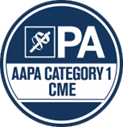Description
Jointly provided by Postgraduate Institute for Medicine and Parkinson & Movement Disorder Alliance
This course will examine medication management in the post-deep brain stimulation (DBS) post-operative period to avoid serious side effects and help ensure positive patient outcomes.
Estimated time to complete activity: 60 minutes
Target Audience
This course is for movement disorder specialists, neurologists, advanced practice providers, and other healthcare professionals involved in the care of patients with a movement or related disorder.
Educational Objectives
After completing this activity, the participant should be better able to:
- Discuss the importance of medication management post-DBS surgery
- Identify patients with dopamine dysregulation syndrome and impulse control disorders
- Employ reliable and purposeful tools in a routine manner to screen for side effects
- Apply changes to post-operative DBS programming/parameters and medication management to alleviate side affects
Faculty
 Jacqueline Cristini, PA-C, MMSc.
Jacqueline Cristini, PA-C, MMSc.
Saint Barnabas Medical Center
Jacqueline Cristini, PA-C, MMSc., is a licensed Physician Associate who specializes in Movement Disorders and Deep Brain Stimulation at Saint Barnabas Medical Center. With a focus on comprehensive care for patients with movement disorders, she also puts a strong emphasis on educational community outreach programs. Along with a multidisciplinary team, she is skilled at providing leading-edge therapies including deep brain stimulation surgery and has specialized in the diagnosis and treatment of Parkinson’s disease, essential tremor and other movement disorders for much of her career.
Disclosure of Conflicts of Interest
Postgraduate Institute for Medicine (PIM) requires faculty, planners, and others in control of educational content to disclose all their financial relationships with ineligible companies. PIM is committed to providing its learners with high quality accredited continuing education activities and related materials that promote improvements or quality in healthcare and not a specific proprietary business interest of an ineligible company.
The faculty reported the following relevant financial relationships with ineligible entities related to the educational content of this CE activity:
Jacqueline Cristini, PA-C, MMSc. – has no disclosures
The PIM planners and others have nothing to disclose.
The PMD Alliance planners and others have nothing to disclose.
All identified conflicts of interest are thoroughly vetted and mitigated according to PIM policy.
Joint Accreditation Statement
 In support of improving patient care, this activity has been planned and implemented by the Postgraduate Institute for Medicine and PMD Alliance. Postgraduate Institute for Medicine is jointly accredited by the Accreditation Council for Continuing Medical Education (ACCME), the Accreditation Council for Pharmacy Education (ACPE), and the American Nurses Credentialing Center (ANCC), to provide continuing education for the healthcare team.
In support of improving patient care, this activity has been planned and implemented by the Postgraduate Institute for Medicine and PMD Alliance. Postgraduate Institute for Medicine is jointly accredited by the Accreditation Council for Continuing Medical Education (ACCME), the Accreditation Council for Pharmacy Education (ACPE), and the American Nurses Credentialing Center (ANCC), to provide continuing education for the healthcare team.
Credit Designation
Physician Continuing Medical Education
The Postgraduate Institute for Medicine designates this enduring material for a maximum of 1 AMA PRA Category 1 Credit(s)™.
Physicians should claim only the credit commensurate with the extent of their participation in the activity.
Physician Assistant Continuing Medical Education
 Postgraduate Institute for Medicine has been authorized by the American Academy of PAs (AAPA) to award AAPA Category 1 CME credit for activities planned in accordance with AAPA CME Criteria.
Postgraduate Institute for Medicine has been authorized by the American Academy of PAs (AAPA) to award AAPA Category 1 CME credit for activities planned in accordance with AAPA CME Criteria.
This activity is designated for 1 AAPA Category 1 CME credits. Approval is valid until August 14, 2025. PAs should only claim credit commensurate with the extent of their participation.
Continuing Nursing Education
The maximum number of hours awarded for this Continuing Nursing Education activity is 1 contact hours.
Computer System Requirements
A smartphone, tablet, or computer with access to the internet.
Disclosure of Unlabeled Use
This educational activity may contain discussion of published and/or investigational uses of agents that are not indicated by the FDA. The planners of this activity do not recommend the use of any agent outside of the labeled indications. The opinions expressed in the educational activity are those of the faculty and do not necessarily represent the views of the planners. Please refer to the official prescribing information for each product for discussion of approved indications, contraindications, and warnings.
Disclaimer
Participants have an implied responsibility to use the newly acquired information to enhance patient outcomes and their own professional development. The information presented in this activity is not meant to serve as a guideline for patient management. Any procedures, medications, or other courses of diagnosis or treatment discussed or suggested in this activity should not be used by clinicians without evaluation of their patient's conditions and possible contraindications and/or dangers in use, review of any applicable manufacturer's product information, and comparison with recommendations of other authorities.
Commercial Support
This activity is supported by independent medical education grants from Abbott, Acadia Pharmaceuticals, GE HealthCare, and Neurocrine Biosciences
Method of Participation and Request for Credit
In order to obtain your CE certificate, please follow the directions provided at the conclusion of the course.
If you have questions regarding the certification of this activity, please contact PIM via email at inquiries@pimed.com or PMD Alliance at education@pmdalliance.org
